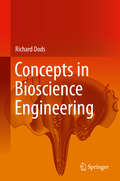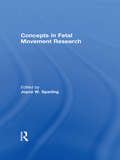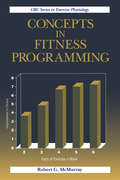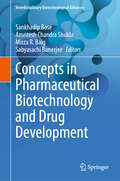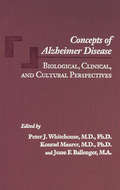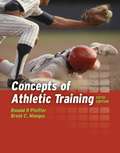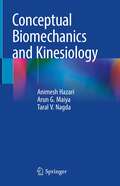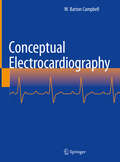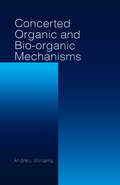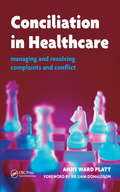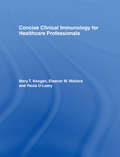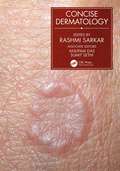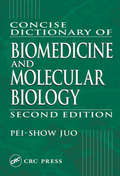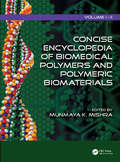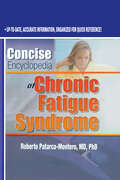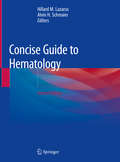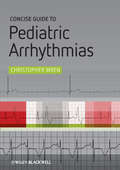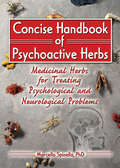- Table View
- List View
Concepts in Bioscience Engineering
by Richard DodsThis textbook teaches bioengineers critical concepts about protein three dimensional structures, how proteins fold, and how the folding affects the functioning of the protein. Protein folding has profound effects on the discovery of biopharmaceutical drugs (especially the transport of immunological compounds to their site of action) as well as on tissue engineering. Dr. Dods covers topics in easily understood terms through the use of glossaries heading each chapter and footnotes and summaries at the end of each chapter. The chapters cover disordered proteins and large sequences of disorder that exists within proteins, secondary structure (α-helix and β-pleated structure), tertiary and quaternary structure, post-translational changes, proteopathies, bioengineering approaches used to study protein folding, and computer software for protein folding. For each of these topics the elements of biomolecular imaging, cellular and tissue engineering, and health care systems engineering are built. Molecular engineering concepts such as site-directed mutagenesis are addressed. For reinforcement of the concepts presented in this text, activities and problems (Queries) are included in the chapter.
Concepts in Fetal Movement Research
by Joyce W SparlingHere is an informative book that provides theoretical perspectives on the study of fetal movement and introduces observational assessments that can be used in fetal research. It provides research tools that can be used to delineate early patterns of movement, preparing therapists for neonatal intervention and leading to a better understanding of functional activity of the fetus. Concepts in Fetal Movement Research describes various ideas in fetal development and contains original research on a variety of topics, including: the way in which events experienced in utero help neonatal interaction with parents inductive and deductive approaches to assessment development scapular movement activity/inactivity of the 12-20 week old fetus two different research tools for assessing fetal movement. future directions for research by physical therapists in collaboration with other researchersResearchers, clinicians, obstetricians, radiologists, sonographers, and neonatologists will all find this book full of helpful information. Concepts in Fetal Movement Research is an invaluable guide for both their research and their day-to-day work with patients.
Concepts in Fitness Programming (Exercise Physiology Ser. #1)
by Robert G. McMurrayConcepts in Fitness Programming presents comprehensive material about various aspects of exercise testing and prescription in a simple, straightforward manner. Intended for individuals who design exercise and fitness programs but who lack extensive background in fitness training, this book provides a wealth of knowledge beyond the basic "how to's"
Concepts in Male Health
by James E. LeoneConcepts in Male Health Concepts in Male Health: Perspectives Across the Lifespan offers a practical approach to understanding the health of males of all races, ethnicities, socioeconomic status, cultures, ages, and orientations. Each chapter of this book comprehensively reviews an important dimension of male health and examines the contributing historical, epidemiological,??psychosocial, cultural-ethical, legal, political, and economic influences. The diverse range of topics allows for complete coverage ranging from body structures??and sexuality to aggression and occupational health. ??The book contains the most recent research and evidence-based science and addresses issues in male health throughout the lifespan in an easy-to-understand format. ??Learning objectives are presented in an accessible format and reflect real life situations. Review questions provided at the end of each chapter address health-specific content included in the chapter and span both the scope and the breadth of the information. This book is ideal for programs in health education, public health, community health nursing, gender studies, and other health sciences.
Concepts in Pharmaceutical Biotechnology and Drug Development (Interdisciplinary Biotechnological Advances)
by Amritesh Chandra Shukla Sankhadip Bose Mirza R. Baig Sabyasachi BanerjeeThis book provides comprehensive coverage of the development of new pharmaceuticals and the enhancement of existing ones. It offers a comprehensive understanding of pharmaceutical biotechnology, including its underlying principles and practical applications from an industrial standpoint. While introducing the roles and applications of biotechnology in drug design and development, the book describes how developments in other fields, like genomics, proteomics, and high-throughput screening, have facilitated the discovery of novel therapeutic targets and drug development methods. It included concepts that are essential to biotechnology and apply to protein therapies. The book provides a thorough overview of the ways in which biotechnology influences drug development, production, and regulation, and is a valuable resource for those seeking to enhance their understanding in this area. This book is designed to support educators in their teaching efforts and offers a reader-friendly exploration of the various stages involved in developing new pharmaceuticals through biotechnology. This book is a valuable resource for individuals in various academic and professional careers, including undergraduates, graduates, pharmaceutical scientists, clinicians, and academic researchers. It provides convenient access to current practices in pharmaceutical biotechnology, making it particularly useful for those working in the interdisciplinary field of biochemistry, pharmacology, biopharmaceutics, and biotechnology. This book's concise and impartial content structure may also benefit corporate researchers.
Concepts of Alzheimer Disease: Biological, Clinical, and Cultural Perspectives (Gerontology)
by Peter J. Whitehouse Konrad Maurer Jesse F. BallengerAs the essays in this volume show, conceptualizing dementia has always been a complex process. With contributions from noted professionals in psychiatry, neurology, molecular biology, sociology, history, ethics, and health policy, Concepts of Alzheimer Disease looks at the ways in which Alzheimer disease has been defined in various historical and cultural contexts.The book covers every major development in the field, from the first case described by Alois Alzheimer in 1907 through groundbreaking work on the genetics of the disease. Essays examine not only the prominent role that biomedical and clinical researchers have played in defining Alzheimer disease, but also the ways in which the perspectives of patients, their caregivers, and the broader public have shaped concepts.
Concepts of Athletic Training Fifth Edition
by Ronald P. Pfeiffer Brent C. MangusThis outstanding introductory text presents key concepts pertaining to the field of athletic training in a comprehensive, logically sequential manner that will assist future professionals in making the correct decisions when confronted with an activity-related injury or illness in their scope of practice.
Conceptual Biomechanics and Kinesiology
by Animesh Hazari Arun G. Maiya Taral V. NagdaThis book presents essential information on the various concepts of biomechanics and kinesiology applied to human body, also describing in depth the understanding of the various physical and mathematical principles applied towards understanding of this science of movement. It tries to simplify this biological movement science by facilitating easy understanding of the various applications of the forces acting on the human body. This book provides a deep insight to the clinical gait analysis and it’s interpretations with graphical outputs, it also covers important topics such as biomechanics of important human joints such as neck, shoulder, spine, hip, knee and ankle with their recent advances. It also includes chapters on biomechanical instrumentation and their interpretation. Another highlight of the book is chapters on biomechanical motion analysis systems used for athletes. This book offers a valuable resource for medical and paramedical students, researchers and clinicians practicing musculoskeletal and manual therapy, aiding researchers gaining insight to human biomechanics.
Conceptual Electrocardiography
by W. Barton CampbellEKG texts currently on the market present EKGs as patterns for rote memorization. This book alternatively presents a uniquely conceptual approach to the interpretation of electrocardiograms. This book contains over 140 exemplary instructive EKGs with an additional 40 self-assessment EKGs. Chapters start with an historical introduction on the nature of EKGs followed by text and illustrations regarding the conceptualization of EKG forces. Further chapters cover specific EKG abnormalities. Included are chapters covering changes which accrue from intraventricular conduction abnormalities, chamber enlargement, ischemic heart disease, COPD, pulmonary embolus, electrolyte abnormalities, basic dysrhythmias and various artifacts. The book is purposefully written to enable utilization of the superior approach of conceptual analysis of electrocardiographic forces as opposed to rote memorization of patterns. Conceptual Electrocardiography is a must-have learning resource for medical students, residents, nurse PAs, critical care and ER physicians, and cardiology fellows and attendings.
Conceptual and Ethical Challenges of Evolutionary Medicine (Ethics of Science and Technology Assessment #53)
by Ozan AltinokThis book analyses the concept of disease, as defined in the context of evolutionary medicine. Upon introducing the reader to evolutionary medicine in its current form and describing its approach to disease instances, the book leverages thoughts and instruments of knowledge of epistemology, social sciences, and ethics to answer the question: “How can we build a timely and appropriate concept of disease?” At first, it looks at the social concerns of medicalization, for example focusing on the suffering of people who have not been diagnosed, or whose suffering is not caused by certain elements that falls under the definitions of disease. In turn, it merges different, both conceptual and empirical considerations in one comprehensive analysis, with the aim of fostering a multidisciplinary understanding of the phenomenon of disease. This book also highlights certain kinds of epistemic injustices that are taking place in the healthcare system, as this is currently conceived in post-industrial societies, thus offering a timely contribution to the current debate around social justice in healthcare.
Conceptualising Public Health: Historical and Contemporary Struggles over Key Concepts
by Johannes Kananen Sophy Bergenheim Merle WesselIn Germanic and Nordic languages, the term for ‘public health’ literally translates to ‘people’s health’, for example Volksgesundheit in German, folkhälsa in Swedish and kansanterveys in Finnish. Covering a period stretching from the late nineteenth century to the present day, this book discusses how understandings and meanings of public health have developed in their political and social context, identifying ruptures and redefinitions in its conceptualisation. It analyses the multifaceted and interactive rhetorical play through which key concepts have been used as political tools, on the one hand, and shaped the understanding and operating environment of public health, on the other. Focusing on the blurred boundaries between the social and the medico-scientific realms, from social hygiene to population policy, Conceptualising Public Health explores the sometimes contradictory and paradoxical normative aims associated with the promotion of public health. Providing examples from Northern Europe and the Nordic countries, whilst situating them in a larger European and international context, it addresses questions such as: How have public health concepts been used in government and associated administrative practices from the early twentieth century up to the present? How has health citizenship been constructed over time? How has the collective entity of ‘the people’ been associated with and reflected in public health concepts? Drawn from a range of disciplinary backgrounds, the authors collected here each examine a particular way of understanding public health and assess how key actors or phenomena have challenged, altered or confirmed past and present meanings of the concept. Conceptualising Public Health is of interest to students and scholars of health and welfare state development from diverse backgrounds, including public health, sociology of health and illness, and social policy as well as medical, conceptual and intellectual history.
Concerted Organic and Bio-Organic Mechanisms (New Directions In Organic And Biological Chemistry Ser. #12)
by Andrew WilliamsThe concept of concerted mechanisms was formulated nearly 90 years ago and virtually all general organic chemistry texts mention it. Until now, however, no monograph has addressed the concept explicitly. Over the last two decades, substantial advancements made in the development of precise methods for elucidating concerted mechanisms have heightened the need for a comprehensive text on the subject.Concerted Organic and Bio-organic Mechanisms gathers the salient materials related to this emerging field into a single text. It sets forth the precise definition of concertedness-along with working sub-definitions-and describes rigorous experimental tools chemists can use to diagnose the existence or absence of concerted mechanisms.Advances in our understanding of concerted mechanisms lead to further questions. Concerted Organic and Bio-organic Mechanisms provides the background and the tools researchers need to consider these important questions and further advance the frontiers of reactions, synthesis, and catalysis.
Conciliation in Healthcare: v. 2, Care and Practice (Radcliffe Ser.)
by Liam Donaldson Anne Ward PlattConciliation is the term used in the National Health Service to describe a particular form of dispute resolution that is used in relation to the complaints process. Conciliation has uses beyond the resolution of complaints. It can be of value in any situation where the clinical relationship has broken down. Equally, it may be used in an attempt to restore relationships as part of conflict management, either within the NHS or in other organisations where conflict or disagreement exists. This concise, practical guide clearly sets out the role of conciliation, and dispels the many misconceptions surrounding procedures and expectations. Conciliation in Healthcare provides invaluable resources for all healthcare staff involved in complaints, either from an operational, strategic or academic perspective. This includes conciliators themselves and those involved in their training, and staff with specific responsibilities for implementing complaints procedures, both in the public and private sectors. It's also highly recommended for those who provide advocacy and support for complainants, as well as those against whom complaints have been made.
Concise Biochemistry
by Anatoly Bezkorovainy Max E. RafelsonThis work offers succinct, medically-oriented coverage of biochemistry, examining biologically important materials and presenting the properties of nucleic acids as well as nucleic acid metabolism. Each metabolic process is integrated in a review of overall energy metabolism, diabetes and starvation. A solutions manual is available to instructors o
Concise Clinical Immunology for Healthcare Professionals
by Mary Keogan Eleanor M. Wallace Paula O'LearyThis up-to-date immunology textbook provides a clear and simple introduction to clinical and laboratory immunology for health professionals in training or in practice. It covers: essential basic immunology clinical immunology laboratory investigations of immunological disorders treatments used in immunological disorders. Focusing on clinical problems seen in practice and including self-assessment questions and case histories to aid learning and understanding, this is an invaluable resource for all medical students, nurses, nutritionists, pharmacists and physiotherapists.
Concise Dermatology
by Rashmi SarkarAs the comprehensive textbooks of Dermatology grow longer and more specialized, there is a need for a text to cut the subject back to the essentials a medical professional needs to know. This concise text from an internationally respected editor presents the most important points about the most significant topics in disease of the skin, hair, and nails; any medical professional will find here the material for a solid grounding in the subject. *Covers the range of dermatology in a consistently manageable level of detail *Answers the need for a reliable concise guide for medical professionals in all specialties *Offers a straightforward and approachable synopsis of the subject
Concise Dictionary of Biomedicine and Molecular Biology
by Pei-Show JuoRapid advances in science, medicine, and molecular biology have created a large amount of new information on biomedicine and molecular biology. Keeping up with the latest information can become a cumbersome task for professionals and students working in these fields. Updated to include new terminology and accurate characterizations of previously ex
Concise Encyclopedia of Biomedical Polymers and Polymeric Biomaterials
by Munmaya MishraThe Concise Encyclopedia of Biomedical Polymers and Polymeric Biomaterials presents new and selected content from the 11-volume Biomedical Polymers and Polymeric Biomaterials Encyclopedia. The carefully culled content includes groundbreaking work from the earlier published work as well as exclusive online material added since its publication in print. A diverse and global team of renowned scientists provide cutting edge information concerning polymers and polymeric biomaterials. Acknowledging the evolving nature of the field, the encyclopedia also features newly added content in areas such as tissue engineering, tissue repair and reconstruction, and biomimetic materials.
Concise Encyclopedia of Biostatistics for Medical Professionals
by Abhaya Indrayan Martin P. HoltConcise Encyclopedia of Biostatistics for Medical Professionals focuses on conceptual knowledge and practical advice rather than mathematical details, enhancing its usefulness as a reference for medical professionals. The book defines and describes nearly 1000 commonly and not so commonly used biostatistical terms and methods arranged in alphabetical order. These range from simple terms, such as mean and median to advanced terms such as multilevel models and generalized estimating equations. Synonyms or alternative phrases for each topic covered are listed with a reference to the topic.
Concise Encyclopedia of Chronic Fatigue Syndrome
by Roberto Patarca MonteroAre you in touch with the latest CFS information?The Concise Encyclopedia of Chronic Fatigue Syndrome summarizes current knowledge about Chronic Fatigue Syndrome (CFS) to help doctors and those working with CFS patients become familiar with recent developments and lessons learned about this and related fatiguing disorders. The information has been thoughtfully organized so that you will be able to easily access and become familiar with highlights of the most relevant topics.The Concise Encyclopedia of Chronic Fatigue Syndrome will bring you up-to-date on advances in cardiovascular medicine, endocrinology, epidemiology, immunology, infectious diseases, neurology, psychiatry, and psychology which have served as the basis for the formulation of new lines of research and novel therapeutic interventions for CFS. You'll find valuable information on the A-to-Z of CFS in the Concise Encyclopedia of Chronic Fatigue Syndrome, including the relationships between: AIDS and fatigue brain injury and fatigue cancer and fatigue as well as: demographics of CFS interstitial cystitis MAO inhibitors neuropsychology of CFS psychosocial measures stress factors tumor necrosis factors ...and much moreComprehensive and thorough, the Concise Encyclopedia of Chronic Fatigue Syndrome highlights areas that need more research and gives you greater awareness of this widespread and growing problem. This compendium will educate and create greater CFS awareness among healthcare professionals and the general public.
Concise Guide to Hematology
by Hillard M. Lazarus Alvin H. SchmaierConcise Guide to Hematology is highly practical, user-friendly, and will be invaluable to all residents, fellows, and trainees working with hematology patients. Designed to highlight the important basic concepts and diseases throughout the spectrum of hematology, the book has a clear and accessible format and includes simple line figures, algorithms, and key points thoughout. Each chapter begins with an overview and then main concepts are outlined for each disorder and topic covered.Edited by two leading figures in the rapidly evolving field of hematology, this attractively-produced and concise book is an essential guide and ready resource for all those undertaking rotations and examinations in the discipline.
Concise Guide to Hematology
by Hillard M. Lazarus Alvin H. SchmaierThis text provides a comprehensive overview of the essential concepts and malignancies of hematology. Now in its second edition, the book reviews every major hematologic disorder and disease entity in thorough detail, from incidence and prevalence to patient and treatment-related issues. Formatted in an organized and easy-to-read outline style to facilitate rapid learning and information processing, the book allows readers to easily locate topics of immediate interest without wading through entire sections to obtain the desired data. Written by a diverse range of experts in the field, Concise Guide to Hematology, Second Edition is a valuable resource for clinicians, residents, trainees, and entry-level fellows who work in or are just entering the field of hematology.
Concise Guide to Pediatric Arrhythmias
by Christopher WrenThis book provides a practical guide to diagnosis and treatment of arrhythmias in children for pediatricians and general pediatric cardiologists. Using multiple ECG examples, the author provides concise descriptions of the key features of each arrhythmia to help the clinician make a diagnosis.
Concise Handbook of Experimental Methods for the Behavioral and Biological Sciences
by Jay E. GouldAlthough there are many books written on the principles and methods of experimentation, few are written in a succinct, comprehensive outline format. The Concise Handbook of Experimental Methods for the Behavioral and Biological Sciences is based on a popular course taught by the author for more than two decades to assist advanced undergraduate and
Concise Handbook of Psychoactive Herbs: Medicinal Herbs for Treating Psychological and Neurological Problems
by Marcello SpinellaFind out how plant-derived drugs react with your brain to produce either healing or harmful results!The Concise Handbook of Psychoactive Herbs will give you a better understanding of herbal products that have psychological effects. The book explores how they work, how effective they are, and what is known about their safety. Geared towards non-specialist professionals and curious individuals, this guide shows how herbal preparations can affect the brain, mental state, and behavior of a user and includes treatment methods, tables, illustrations, a glossary, and a bibliography.The Concise Handbook of Psychoactive Herbs contains chapters on several types of psychoactive herbs, including: stimulants cognition-enhancers sedatives painkillers hallucinogensWith the Concise Handbook of Psychoactive Herbs, you&’ll examine the effects of psychoactive drugs on the nervous system-both positive and negative. Each chapter discusses a type of herbal medicine, its action on the brain and other systems of the body, side effects, and the potential for addiction. The book closely examines possible drug interactions with prescription medications and emphasizes the caution you need to take when using herbal health products.In the Concise Handbook of Psychoactive Herbs you will learn about the psychoactive actions of such medicinal plants as: coffee tobacco cannabis ginseng chamomile cocoa opium poppy peyote gingko biloba
